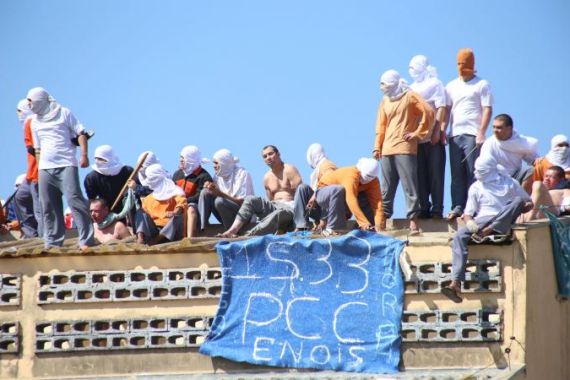The horror of Brazil’s prisons
With more than 500,000 people currently incarcerated, Brazil’s inmates continue to control the overcrowded prisons.

Scenes of absolute horror, as hundreds of inmates at a prison in Cascavel, Brazil riot and decapitate two inmates from a rival gang and take two prison guards hostage.
As I write this, it’s a cold and tense standoff that has been going on for more than 30 hours as police try to negotiate to end it all.
There are reports the kidnappers are torturing their prison guard captives. Images show the guards stripped to their underwear on the prison roof, hands tied behind their back, surrounded by furious masked inmates wielding knives.
Other inmates who didn’t want to cooperate with the riot are reportedly being pushed off the prison roof.
As ugly as it is, it’s just a snapshot of a wider problem.
Right now there are about 574,000 people incarcerated in Brazil. Only the US, China, and Russia have more people jailed.
Perspective: The entire population of Iceland is 317,000 and the population of the US state of Wyoming is about 580,000.
The problem here is two-fold: First, more inmates are going in the system and less coming out. About eight years ago a new law was put into place dramatically increasing the sentencing as well as the power of police to jail anybody possessing drugs on charges of trafficking.
The prison population jumped about 400 percent.
Today, for every one public defender in Brazil, there’s often a backlog of 2,000 cases to handle, meaning less people exiting the system once they go in.
Only the rich and well-connected people arrested can afford the lawyers to get to the front of the line or get transferred to one of the few federal prisons for VIP inmates. Everyone else rots in the regular jails, the worst place to be.
I saw it first hand earlier this year as I gained access to one of Brazil’s most overcrowded prisons in the city of Porto Alegre. The conditions were inhumane.
Everywhere, in jails all over the country, prison guards are undermanned.
In Cascavel, the prison was at maximum capacity reportedly housing 1.040 inmates. There were only nine guards at the time of the riot.
The open secret in Brazil is that with such overcrowding, prison guards usually can only keep the peace by handing control of the prison to the inmates.
Back in 2007 I did a story about a teenage girl, accused of shoplifting candy, who was thrown into an overcrowded cell packed with all men. She was repeatedly raped over several weeks.
The story caused brief, nationwide outrage and promises to fix the jail system, but then it all faded away.
That brings me to the second part of the Brazil prison problem: Even with two inmates decapitated, nobody seems to much care.
As I write, none of Brazil’s major national news websites have it as their top story. It’s buried below news about minor developments in the presidential election, a small explosion in a shopping mall in Brasilia that injured two people, or the death of a well-known businessman. The website for O Globo, Rio’s biggest newspaper, has the Cascavel jail-riot story buried so low it’s right next to a story about the Emmy awards.
Violent prison riots have become so common many Brazilians have seemed to have developed numbness to the despicable nature of it all.
The attitude seems to be, “as long as the bad guys kill each other while behind bars, so be it”.
While Brazilians in the last year have rightly been calling for better healthcare, education, and public transportation, nobody seems all that interested in fixing prison overcrowding, or tackling the root causes.
There are no easy solutions.
But the first step is acknowledging there is a problem.
Waking up to the fact that people are cutting each other’s heads off in your country should be all anyone needs to realise something isn’t right and needs fixing.
Brazil has a serious problem, whether Brazil want’s to admit it or not.
Ignoring it clearly hasn’t worked.
Follow Gabriel Elizondo on Twitter @elizondogabriel